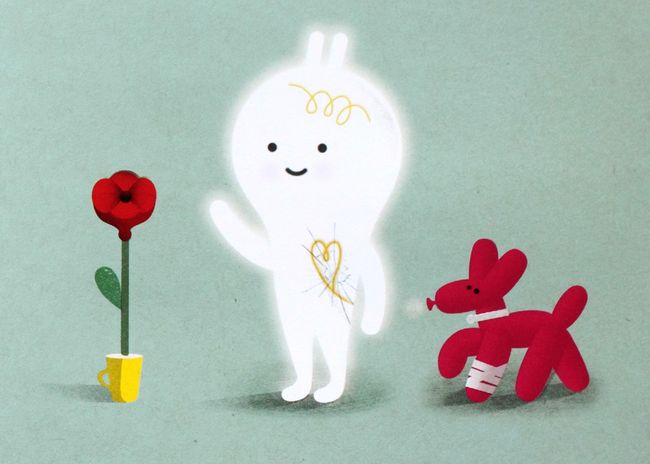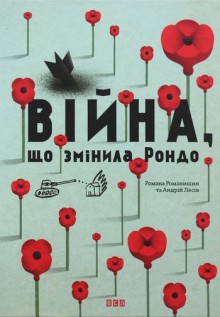Early in 2015, Old Lion Publishing House released book The War That Changed Rondo, authored and illustrated by members of the Agrafka Creative Workshop Romana Romanyshyn and Andrii Lesiv. The book immediately attracted the attention of readers and literary critics, and for good reasons: firstly, it deals with the topic of war, which is what we are experiencing now; secondly, this is a children’s book on this difficult subject. How many children’s books can you name, either Ukrainian or translated, which are devoted to armed conflicts and the phenomenon of war? Thirdly, this is a stylish and modern book.
No wonder that the book was recognized first by readers, and then by competent juries of BolognaRagazzi Award, one of the most prestigious and well-known in the children’s books industry. Each year, it sees hundreds of books from around the world nominated for it. By the way, this is Agrafka’s second award from BolognaRagazzi. Their book Stars and Poppy Seeds won in the Opera Prima category in 2014.
“This book is, above all, our reflection on the past year’s events in Ukraine. This is an attempt to explain and to some extent reorder our thoughts, emotions, feelings associated with the war which, just like in the book, suddenly burst into our lives,” Lesiv and Romanyshyn said. They went on to explain: “We wanted to create a book about more than the ongoing war in Ukraine, to make it more universal, because such events are now taking place in many parts of the world.”
The main characters of the book are three friends: Danko, Zirka, and Fabian. They live in the town of Rondo and enjoy their everyday experiences. Danko rides a bike and loves vintage floral engravings, Fabian looks for treasures, and Zirka’s favorite pastime is traveling. The city’s center hosts a huge greenhouse with wonderful singing flowers. All townspeople and visitors to Rondo come there every day to listen to them singing. Joyful and calm, the town lives on, until the war comes to it one day...
“We wanted to show the world of fragile and vulnerable creatures, completely defenseless against war and violence. The three main characters are created just of such fragile and short-lived substances: glass, paper, and a balloon. However, these vulnerable creatures are very bold and decisive, they are not afraid, and this is their strongest weapon against the war. We were all just as vulnerable before our war came, no one is born for war. But it is important to find the inner strength to accept real events without experiencing a paralyzing fear,” Lesiv and Romanyshyn said.
The war as pictured in the book is a full-fledged character. It is black and terrible, bringing destruction, disorder, and permanent darkness. It sows hundreds of black flowers on its way. Townspeople disappear... However, this darkness can be overcome.

“When war comes, it touches everyone, it is impossible to hide from it or to stay indifferent, and we try to present these simple truths in an accessible symbolic language in this book. We thus create a vector for follow-on sincere conversations between parents and children about the war and ways to confront and combat it. In addition, we consciously decided not to make the book into a straight journalistic report. We have no particular enemy in it, the war itself is a character of its own, but death is only symbolically hinted at,” the authors explained. Incidentally, when working on the black flower of war image, the creators were inspired by Maria Prymachenko’s legacy. In general, the reader sees many flowers in the book, ranging from the amazing singing flowers serving as a symbol of peaceful life, to the black ones which act as a symbol of war, and red poppies which stand for the fallen in the wars... “Flowers make a very Ukrainian image, as they bring forth allusions to folk art, folklore, and flowers as a symbol of memory and respect for the living and the fallen heroes. For example, we were very impressed with Prymachenko’s war-themed works, including the title of one of them: Damn War! Bombs Grow instead of Flowers,” the book’s authors explained.
The book has the townspeople winning at the end. They come together and, having joined their forces to pedal a special machine, produce light. The light dissolves the darkness of the war. “The light means education, culture, intelligence, and memory here. ‘Light’ and ‘enlightenment’ are cognates. In our opinion, the war can be won only together. It is important that everyone make their best to operate their wheel in this collective change machine, that everyone find their special purpose and make their unique contribution to the common cause. The main thing is not to remain indifferent,” Lesiv and Romanyshyn explained.

According to the authors of The War That Changed Rondo, it is essential to discuss such topics with children now. “The information field is helping to create chaos now, stressing people and making them worry. Books make it possible to structure events. This applies to the arts and culture in general, not just books. Children share the information space with us adults, so we cannot protect them from these news and worries. That is why we should talk to children about such complex subjects, and books can serve as a good starting point for such conversations. More than anything, we try to be honest in this book. Of course we are optimistic regarding the final victory, because the book deals with the commonly held human truths, such as the struggle between good and evil, the importance of unity and working responsibly together, the importance of each individual’s actions as well as the common effort. However, we do not say in it that victory is the end of the story, as the war is followed by a painful rethinking, reconstruction, and return to peaceful life. The war changes us all and scars our bodies and our hearts alike,” Lesiv and Romanyshyn said. “It is important to choose a correct language for communicating these things to children, to talk to them as equals, but without excessively simplifying issues. The symbolic language can be a good way of such communication. After all, our ancestors understood this well and used fairy tales to present many important topics of life to children.”








